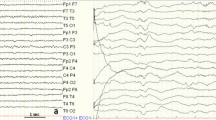Summary
The activation of focal epileptic activities during wakefulness, slow and REM sleep was studied in chronic experiments in 20 epileptic cats (Kopeloff's method). The lesions were produced in the nucleus amygdaloideus (pars basolateralis), hippocampus dorsalis, formatio reticularis mesencephali and in the isocortex. Each animal was observed from between 3 to 60 days and a total of 442 hours of polygraphy (E.E.G., E.M.G, Eye movements) were recorded. Within the first 7 days all animals showed E.E.G paroxysms and most of them showed seizures from the beginning of the second week.
In those cats with subcortical lesions there was no change detected in the duration, distribution and organisation of the different sleep phases. The paroxysmal E.E.G activity seen in the wakeful animal were not activated or focalised during slow-wave sleep; in REM sleep the paroxysms disappeared completely, only a few spindles were seen.
Animals with lesions in the isocortex rarely showed paroxysms during the slow wave sleep. However, during REM sleep a clear focalisation was seen, although there was no additional activation in the area of the lesion.
In all animals the most significant of the paroxysms was seen during a state which we should like to describe as; “Awake without any motor activity”. It is assumed that this state corresponds to the state of falling asleep in man.
Zusammenfassung
Die Frage der Wacho- der Schlaf-Aktivierung der fokalen Epilepsien wird bei 20 epileptischen Katzen im chronischen Experiment untersucht (Kopeloff-Methode). Die Narben wurden im Nucleus amygdaloideus (Pars basolateralis), Hippocampus dorsalis, Formatio reticularis mesencephali, Isocortex gesetzt. Bei einer Untersuchungsdauer der einzelnen Tiere zwischen 3 und 60 Tagen, wurden insgesamt 442 Std in Polygraphie (EEG, EMG, Augenbewegungen) abgeleitet. Die Tiere zeigten innerhalb der ersten 7 Tage Krampfpotentiale im EEG und die meisten ab der 2. Woche Krampfanfälle.
Bei Katzen mit subcorticalen Narben war keine Veränderung der Dauer, der Verteilung und der Organisation der einzelnen Schlafstadien nachweisbar. Die im Ruhe-EEG vorhandenen Paroxysmen wurden während des langsamen Schlafes nicht aktiviert und fokalisiert. Im paradoxen Schlaf waren die Krampfpotentiale völlig desaktiviert, es traten einzelne Spindeln auf. Die Tiere mit Narben im Isocortex zeigten im langsamen Schlaf seltene Paroxysmen. Während der häufigeren kurzen Phasen des paradoxen Schlafes war eine Fokalisierung der Spitzen im Bereich der Läsion nachweisbar, jedoch, keine Aktivierung. Bei allen Tieren war die ausgeprägteste Aktivierung der Krampfbereitschft stets in dem von uns als „Wach mit motorischer Inaktivität“ bezeichnete Phase zu bemerken. Daher wird angenommen, daß dieser Zustand bei der Katze mit dem Einschlafstadium des Menschen vergleichbar ist.
Similar content being viewed by others
Literatur
Andrioli, G., F. Angeleri, P. Bergonzi, P. Cantore, A. Ferroni, A. Gentilomo, S. Mingrino, G. B. Ricci, G. Rosadini e G. F. Rossi: Inquadramento diagnostico dell'epilettico in Neurochirurgia. Minerva neurochir. 10, 49–144 (1966).
Bancaud, J., J. Talaraich, M. Bordas-Ferrer, J. L. Auber et H. Marchand: Les accés épileptiques au cours du sommeil de nuit. In: Le sommeil de nuit normal et pathologique, pp. 255–274, Paris: Masson 1965.
Baumgarten, R. Von, A. Mollica e G. Moruzzi: Modulazione della frequenza di scarica dei neuroni bulboreticolari prodotta con stricnizzazione dell'area corticale mortrice. Boll. Soc. ital. Biol. sper. 29, 1376 (1953).
Cadilhac, J., et P. Passouant: L'influence des différentes phases du sommeil nocturne sur les décharges épileptiques chez l'homme. In: M. Jouvet ed.: Aspects anatomo-fonctionelles de la physiologie du sommeil. Colloques Internationaux du Centre National de la Recherche Scientifique, pp. 555 à 570. Paris: CNRS 1965.
Dipaola, M., e G. F. Rossi: Induzione del sonno desincronizzato nel gatto mediante stimolazione elettrica di diverse area della corteccia cerebrale. Boll. Soc. ital. Biol. sper. 41, 659–661 (1964).
Dolce, G., e C. A. Tassinari: L'E.E.G. nel sonno. In: La elettroencefalo grafia nella clinica e nella pratica. Roma: E.I.A.S. 1965.
Gastaut, H., M. Balleto, J. Rhode, C. Batini et J. Fressy: Etude du sommeil nocturne de 9 sujets présentant un état de mal épileptique généralisé ou focalisé. Rev. neurol. 108, 173 (1963).
—, C. Batini, R. Broughton, J. Fressy et C. A. Tassinari: Etude électrographique des manifestations paroxystiques, non-épileptiques au cours du sommeil nocturne. Rev. neurol. 110, 309–310 (1964).
—, and J. Fressy: On epileptic attacks recorded during the night sleep of epileptic children. Electroenceph. clin. Neurophysiol. 14, 142 (1963).
—, R. Broughton et C. A. Tassinari: Etude électrographique du sommeil nocturne chez les épileptiques. Rev. neurol. 110, 311–313 (1964).
—, and F. Vittini: Etude électroencephalographique des phénoménes épisodiques épileptiques au cours du sommeil. In: Le sommeil de nuit normal et pathologique, pp. 239–254. Paris: Masson 1965.
Jasper, H. H., and C. Ajmone-Marsan: A stereotaxic atlas of the deencepha lon of the cat. Publ. by National Research Council of Canada. OH... 2/1960.
Kopeloff, N., J. R. Whitier, B. L. Pacella, and L. Kopeloff: The epileptogenic effect of subcortical alumina cream in the rhesus monkey. Electroenceph. clin. Neurophysiol. 2, 163–168 (1950).
Schwartz, B. A., G. Guilbaud, and H. Fischgold: Single and multiple spikes in the night sleep of epileptics. Electroenceph. clin. Neurophysiol. 16, 56–67 (1964).
Author information
Authors and Affiliations
Additional information
Wesentliche Teile dieser Arbeit sollen von Herrn Dieter Blümler der Medizinischen Fakultät Frankfurt am Main als Dissertation vorgelegt werden.
Rights and permissions
About this article
Cite this article
Dolce, G., Blümler, D. & Fromm, H. Schlaf-EEG und Epilepsie bei Katzen mit chronischen epileptogenen Hirnläsionen. Archiv für Psychiatrie und Zeitschrift f. d. ges. Neurologie 211, 155–169 (1968). https://doi.org/10.1007/BF00344411
Received:
Issue Date:
DOI: https://doi.org/10.1007/BF00344411




